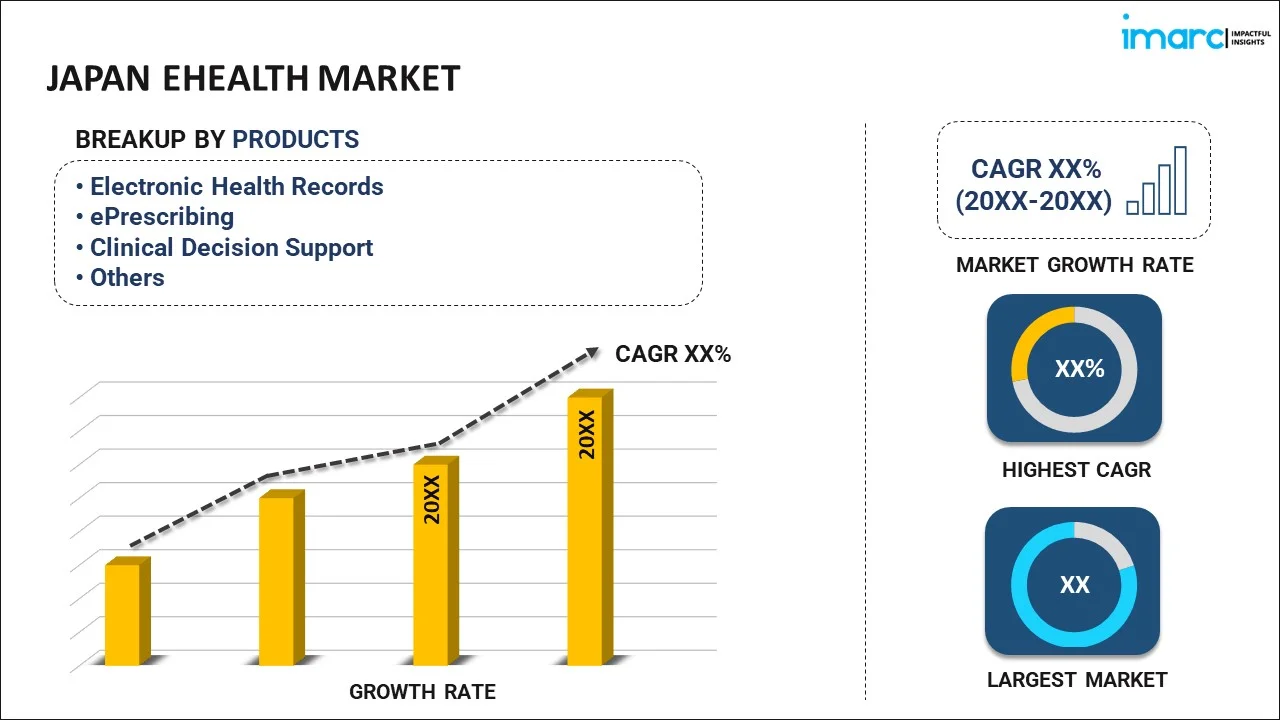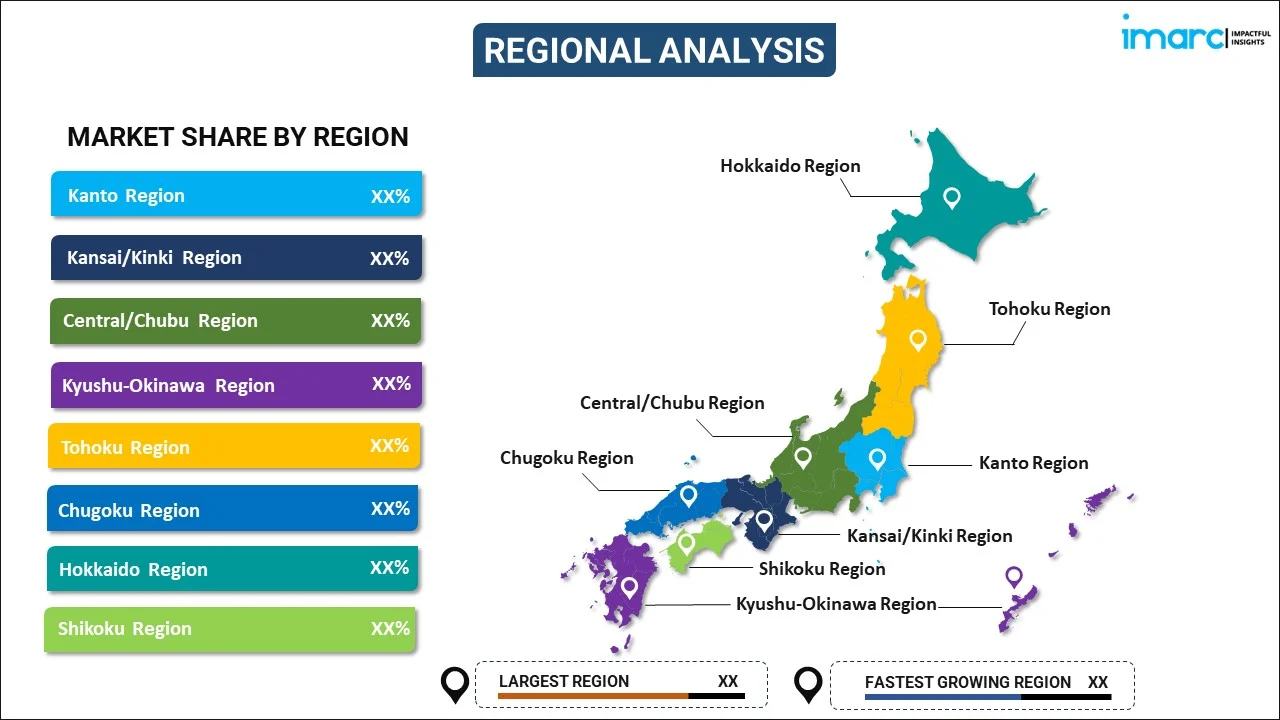
Japan eHealth Market Report by Product (Electronic Health Records, ePrescribing, Clinical Decision Support, Telemedicine, Consumer Health Information, mHealth, and Others), Service (Monitoring, Diagnostic, Healthcare Strengthening, and Others), End User (Healthcare Providers, Payers, Healthcare Consumers, and Others), and Region 2025-2033
Market Overview:
Japan eHealth market size reached USD 8,338.9 Million in 2024. Looking forward, IMARC Group expects the market to reach USD 24,031.8 Million by 2033, exhibiting a growth rate (CAGR) of 12.50% during 2025-2033. The growing consumer inclination towards patient-centric care and enhanced healthcare infrastructures is primarily driving the regional market.
|
Report Attribute
|
Key Statistics
|
|---|---|
|
Base Year
|
2024 |
|
Forecast Years
|
2025-2033
|
|
Historical Years
|
2019-2024
|
| Market Size in 2024 | USD 8,338.9 Million |
| Market Forecast in 2033 | USD 24,031.8 Million |
| Market Growth Rate (2025-2033) | 12.50% |
eHealth encompasses the utilization of information and communication technologies (ICTs) to deliver healthcare services. Its primary objective is to enhance the accessibility, efficiency, and quality of healthcare by employing electronic means. eHealth facilitates various aspects of healthcare, including physical and psychological diagnoses, treatment, monitoring of vital signs, teleconsultation, and electronic prescription services. Its application is particularly valuable in remote or geographically isolated regions where conventional healthcare services are limited or unavailable. The increasing penetration of the internet has propelled the widespread adoption of eHealth, as it simplifies the process of identifying optimal treatment options and enables the early detection of illnesses. Additionally, eHealth offers the convenience of communicating with healthcare professionals through various electronic mediums, including email, text, audio, video, and more. This has made eHealth an integral part of modern healthcare, bridging geographical gaps and facilitating effective healthcare delivery.
Japan eHealth Market Trends:
The Japan eHealth market is experiencing notable growth, driven by several key factors. The growing awareness of the advantages provided by eHealth solutions is a significant driver. These solutions empower patients to monitor their health parameters remotely through mobile health (mHealth) applications and telemedicine services. This enables faster and direct communication between patients and healthcare professionals, allowing the remote recording and sharing of medical records, reducing the necessity for in-person hospital visits. The evolving healthcare landscape in Japan, marked by a shift towards patient-centric care and enhanced healthcare infrastructure, is further propelling the adoption of eHealth solutions. Additionally, the integration of the Internet of Things (IoT) with smartphones has enabled real-time data access and reduced errors, making eHealth solutions more accessible and efficient. Furthermore, healthcare regulatory authorities are actively promoting eHealth services, especially in light of the ongoing coronavirus disease (COVID-19) pandemic. These efforts aim to harness the potential of this technology to combat the rapid spread of the virus and enhance healthcare delivery in both high and low-income economies. In confluence of factors underscores the positive growth outlook for the eHealth market in Japan.
Japan eHealth Market Segmentation:
IMARC Group provides an analysis of the key trends in each segment of the market, along with forecasts at the country level for 2025-2033. Our report has categorized the market based on product, services, and end user.
Product Insights:

- Electronic Health Records
- ePrescribing
- Clinical Decision Support
- Telemedicine
- Consumer Health Information
- mHealth
- Others
The report has provided a detailed breakup and analysis of the market based on the product. This includes electronic health records, ePrescribing, clinical decision support, telemedicine, consumer health information, mHealth, and others.
Services Insights:
- Monitoring
- Diagnostic
- Healthcare Strengthening
- Others
A detailed breakup and analysis of the market based on the services have also been provided in the report. This includes monitoring, diagnostic, healthcare strengthening, and others.
End User Insights:
- Healthcare Providers
- Payers
- Healthcare Consumers
- Others
The report has provided a detailed breakup and analysis of the market based on the end user. This includes healthcare providers, payers, healthcare consumers, and others.
Regional Insights:

- Kanto Region
- Kansai/Kinki Region
- Central/ Chubu Region
- Kyushu-Okinawa Region
- Tohoku Region
- Chugoku Region
- Hokkaido Region
- Shikoku Region
The report has also provided a comprehensive analysis of all the major regional markets, which include Kanto Region, Kansai/Kinki Region, Central/ Chubu Region, Kyushu-Okinawa Region, Tohoku Region, Chugoku Region, Hokkaido Region, and Shikoku Region.
Competitive Landscape:
The market research report has also provided a comprehensive analysis of the competitive landscape. Competitive analysis such as market structure, key player positioning, top winning strategies, competitive dashboard, and company evaluation quadrant has been covered in the report. Also, detailed profiles of all major companies have been provided.
Japan eHealth Market Report Coverage:
| Report Features | Details |
|---|---|
| Base Year of the Analysis | 2024 |
| Historical Period | 2019-2024 |
| Forecast Period | 2025-2033 |
| Units | Million USD |
| Scope of the Report | Exploration of Historical and Forecast Trends, Industry Catalysts and Challenges, Segment-Wise Historical and Predictive Market Assessment:
|
| Products Covered | Electronic Health Records, ePrescribing, Clinical Decision Support, Telemedicine, Consumer Health Information, mHealth, Others |
| Services Covered | Monitoring, Diagnostic, Healthcare Strengthening, Others |
| End Users Covered | Healthcare Providers, Payers, Healthcare Consumers, Others |
| Regions Covered | Kanto Region, Kansai/Kinki Region, Central/ Chubu Region, Kyushu-Okinawa Region, Tohoku Region, Chugoku Region, Hokkaido Region, Shikoku Region |
| Customization Scope | 10% Free Customization |
| Post-Sale Analyst Support | 10-12 Weeks |
| Delivery Format | PDF and Excel through Email (We can also provide the editable version of the report in PPT/Word format on special request) |
Key Questions Answered in This Report:
- How has the Japan eHealth market performed so far and how will it perform in the coming years?
- What has been the impact of COVID-19 on the Japan eHealth market?
- What is the breakup of the Japan eHealth market on the basis of product?
- What is the breakup of the Japan eHealth market on the basis of services?
- What is the breakup of the Japan eHealth market on the basis of end user?
- What are the various stages in the value chain of the Japan eHealth market?
- What are the key driving factors and challenges in the Japan eHealth?
- What is the structure of the Japan eHealth market and who are the key players?
- What is the degree of competition in the Japan eHealth market?
Key Benefits for Stakeholders:
- IMARC’s industry report offers a comprehensive quantitative analysis of various market segments, historical and current market trends, market forecasts, and dynamics of the Japan eHealth market from 2019-2033.
- The research report provides the latest information on the market drivers, challenges, and opportunities in the Japan eHealth market.
- Porter's five forces analysis assist stakeholders in assessing the impact of new entrants, competitive rivalry, supplier power, buyer power, and the threat of substitution. It helps stakeholders to analyze the level of competition within the Japan eHealth industry and its attractiveness.
- Competitive landscape allows stakeholders to understand their competitive environment and provides an insight into the current positions of key players in the market.
Need more help?
- Speak to our experienced analysts for insights on the current market scenarios.
- Include additional segments and countries to customize the report as per your requirement.
- Gain an unparalleled competitive advantage in your domain by understanding how to utilize the report and positively impacting your operations and revenue.
- For further assistance, please connect with our analysts.
 Request Customization
Request Customization
 Speak to an Analyst
Speak to an Analyst
 Request Brochure
Request Brochure
 Inquire Before Buying
Inquire Before Buying




.webp)




.webp)












